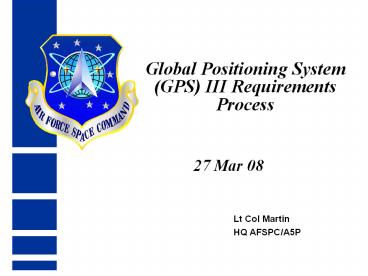Global Positioning System (GPS) III Requirements Process - PowerPoint PPT Presentation
Title:
Global Positioning System (GPS) III Requirements Process
Description:
Global Positioning System (GPS) III Requirements Process 27 Mar 08 Lt Col Martin HQ AFSPC/A5P Example: Geodetic Requirement Notional GPS III CDD Timeline for KDP-C ... – PowerPoint PPT presentation
Number of Views:158
Avg rating:3.0/5.0
Title: Global Positioning System (GPS) III Requirements Process
1
Global Positioning System (GPS) III Requirements
Process
- 27 Mar 08
Lt Col Martin HQ AFSPC/A5P
2
Overview
- What was the process that got us here?
- How does it all work?
- What are the current requirements?
- How do we go forward on GPS III?
2
3
What was the process that got us here?
- The Interagency Requirements Process
- Civilian and Military agencies are Part of It
- We are in this together to make GPS better
3
4
Interagency Requirements Process
5
Example Geodetic Requirement
- Interagency Study Group (NASA, NOAA, NGA, NRL,
USNO, USGS) defined GPS III Geodetic Requirement - Completed AoA pointing to laser ranging of GPS as
optimal solution - Requirement and AoA submitted to IFOR Apr 07
- Support letters from NASA and NGA submitted to
IFOR Jul 07 - Geodetic requirement accepted by IFOR 20 Aug 07
- GPS Wing tasked with identifying
costs/risk/impacts by 1 Jun 08 - EXCOM tasked NASA/Air Force (20 Mar 08) to
complete compatibility assessment of laser
reflectors on GPS by 30 Sep 08 - Pending assessment, Geodetic requirement added to
GPS III CDD for Increment B
6
GPS III Capabilities Development
- 2000Operational Requirements Document (ORD)
- 2000 Navigation Warfare Analysis of Alternatives
(Navwar AoA) - 2005Joint Requirements Oversight Council (JROC)
approved initial Capability Development Document
(iCDD) - Validated GPS III Key Performance Parameters
(KPP) for single increment - JROC approved US Nuclear Detonation Detection
System (USNDS) as payload - 2006JROC approved iCDD addendum
- Low risk, time-certain Incremental approach (A,
B, and C) - 2007JROC approved CDD for Increments A, B, and C
- Validated requirements for GPS Block III A
satellites and Next Generation Control Segment
(OCX) Increments I and II - Future JCIDS Documents
- CDDs updated prior to all KDPs for each
Increment CPD prior to each build approval - Next CDD update for Increment A KDP-C (2009)
GPS III requirements process ensures military and
civil requirements properly addressed
6
7
How Does it All Work?
- All new GPS III requirements were approved by the
Interagency Forum for Operational Requirements
(IFOR) - All requirements included justification and
rationale - Feasibility, affordability, and best value to
government key considerations for approval - GPS Wing provides additional cost/benefit
analysis - Civil requirements should be approved by IFOR
prior to commencement of High Performance Team
(HPT) - Unresolved IFOR issues raised to Interagency
Review Board (IRB) for adjudication or to the
Interagency Requirements Oversight Council (IROC)
if not resolved by the IRB
8
Requirements Development/Adjudication
- High Performance Team (HPT) includes civil reps,
initially merges requirements for CDD - Based on higher level documents (JCD, ICD,
CONOPS, etc) - Incorporates civil requirements approved via IFOR
- Civil requirements require appropriate-level
approval from within agency - Requirements included in CDD based on cost, risk,
and operational utility - Recommends threshold and objective values and
KPPs based on inputs from requesting
agency/service - All performance values require rationale from
submitter - CDD coordinated through DoD (AFROCC, FCB, JCB,
and JROC) and civil agencies (Ext. DOT Pos/Nav
W/G EXCOM) - Unresolved policy related issues can be elevated
to EXCOM for resolution
9
What are the Current Requirements?
- Selected GPS III A Requirements for the
Interagency - Backward Compatibility
- GPS III works with legacy receivers
- Availability of Position Accuracy
- Supports military ops, transportation industry,
aviation, surveying - Position and Time Integrity
- Essential for safety-of-life applications
- Time Transfer Accuracy
- Essential for time-synchronization of numerous
military and civil systems - GPS/Galileo Interoperability (L1C)
- International agreements require commonality with
Galileo/GLONASS and regional augmentation systems - Signal Monitoring
- Supports safety-of-life applications
10
Notional GPS III CDD Timeline for KDP-C (Jul 09)
How Do We Go forward on GPS III?
- Aug 08 Requirement Strategy Review
- Aug 08 IFOR
- Sept 08 High Performance Team (HPT)
- Dec 08 AFROCC
- Jan 09 Functional Capabilities Board
- Jan 09 Joint Capabilities Board
- Feb 09 JROC
Civil Agencies Welcome at Each Event
11
Requirements Process Improvements
- AFSPC reorganization designates a single O-6
Command Lead for each capability - PNT Capability Team facilitates, coordinates, and
synchronizes PNT Issues - Improves/restores ability to execute strategic
level mission activities - Pro-active cross-functional integration
- Recognized AFSPC focal point
- Single HQ AFSPC POC for customers, suppliers,
mission partners, and HHQ - Facilitator, coordinator, synchronizer not a
management layer
DOT Liaison at AFSPC coordinates input of civil
requirements































